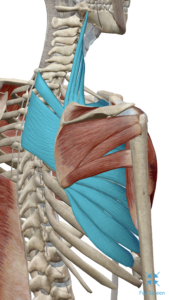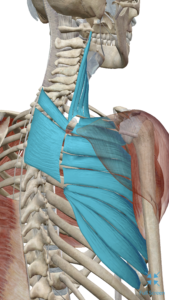Anatomists love to separate and name things. Despite their different names and identities, an understanding of three muscles is essential to understanding one of the most common Myofascial pain patterns of the upper back and neck. The three muscles are the Levator Scapulae, the Rhomboid complex, and the Serratus Anterior.
 Levator Scapulae goes up the neck to the base of the skull, the Rhomboid Complex between the shoulder blade and spine and finally the Serratus Anterior that runs under the shoulder blade and attaches to the rib cage. The Serratus Anterior dwarfs the other two in size.
Levator Scapulae goes up the neck to the base of the skull, the Rhomboid Complex between the shoulder blade and spine and finally the Serratus Anterior that runs under the shoulder blade and attaches to the rib cage. The Serratus Anterior dwarfs the other two in size.
Here is a picture of the complex with the shoulder blade. All three muscle groups are attached to the edge of the shoulder blade closest to the spine. Every time we move our arm forward, these muscles begin a stabilizing balancing act. As the arm moves forward, the shoulder blade must also ‘swing’ forward, pivoting at the top of the shoulder blade near the spine. 
 If we remove the shoulder blade from the picture, we can easily see their relationship with one another. It is important to note the size differences of each muscle. Remember the old adage, form follows function? Look at the three muscles and guess which one is a major player in arm movement. The Serratus Anterior.
If we remove the shoulder blade from the picture, we can easily see their relationship with one another. It is important to note the size differences of each muscle. Remember the old adage, form follows function? Look at the three muscles and guess which one is a major player in arm movement. The Serratus Anterior.
Clients often present themselves with pain right along the spine, right in the Rhomboid complex. This usually is because of their poor ergonomics at work or some form of aggressive exercise. Basically, they are extending their arm for long periods of time. The small Rhomboid complex just can’t keep up balancing the action and work of the super-sized Serratus Anterior.
Pain Along the Spine
Although the Rhomboid complex is very compact and strong, balancing off the Serratus for extended periods of time is not the position it cares to play. Both Serratus and Rhomboids participate in the movement. They are both active. However, when the Serratus Anterior becomes overactive, pain develops in the Rhomboids. There is no way for the Rhomboid to rest, eventually ‘burning’ itself out. Thus a ‘burning’ pain along the spine.
Headaches at the base of the skull
Eventually, pain kicks in at the base of the skull because the Levator Scapulae becomes tired as well. This can begin a vicious cycle of muscle tension headaches beginning at the base of the skull.
The Solution
Two things have to happen in order to make progress in this case.
First, understanding the ergonomics and dynamics of your activity or workstation is key to improving your health. Your pain pattern just will not change much if your form or workstation doesn’t change.
Second, appropriately address the muscle imbalance using a variety of Manual Therapy and Myofascial techniques are vital in restoring the functional balance.
Understanding the “why” is just as important as finding an educated therapist with experience.
After 22 years of helping people, I have plenty of experience in addressing this very common issue.
